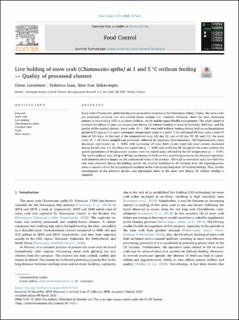| dc.description.abstract | Snow crab (Chionoecetes opilio) has become an essential resource in the Norwegian fishery. Today, the snow crabs are processed on-board into two cooked-frozen sections (i.e., clusters). However, there has been increasing interest in live holding (LH) in on-shore facilities, which enables more flexible management. This study aimed to evaluate the effects of time and temperature during LH without feeding in terms of mortality, limb loss, and the quality of the cooked clusters. Snow crabs (N = 150) were held without feeding during both an acclimatization period of 21 days at 4 °C and a subsequent temperature study at 1 and 5 °C for additional 90 days, with a total LH time of 111 days. At the start of the temperature study (LH day 21) and at LH day 49, 89, and 111, the snow crabs (N = 28) were sampled and processed, followed by analytical determinations. The hepatosomatic index decreased significantly (p < 0.05) with increasing LH time. Both cluster yield and meat content decreased during the LH time, but the effect was significant (p < 0.05) only at LH day 89. Except for the water content, the quality parameters of the processed clusters were not significantly affected by the LH temperature (p > 0.05). The results indicate that LH up to 89 days in absence of feed can be a possible practice for the business operators, with minimal adverse impact on the commercial value of the product. Although no mortality and a low limb loss rate were observed during the holding period, the marked mobilization of nutrients from the hepatopancreas raises a concern about the physiological condition of the crab during long-term LH without feeding. Thus, further investigation of the potential distress and nutritional status of the snow crab during LH without feeding is required. | |
